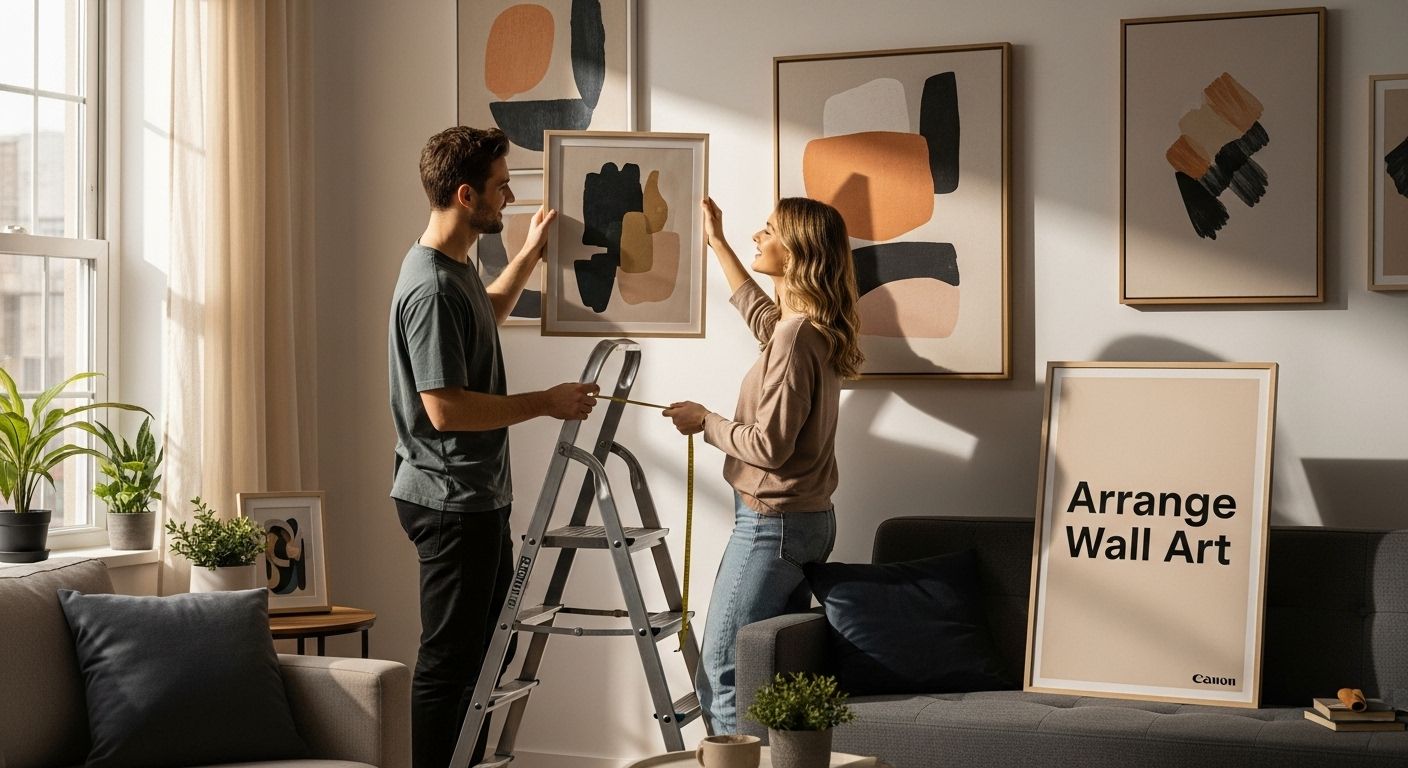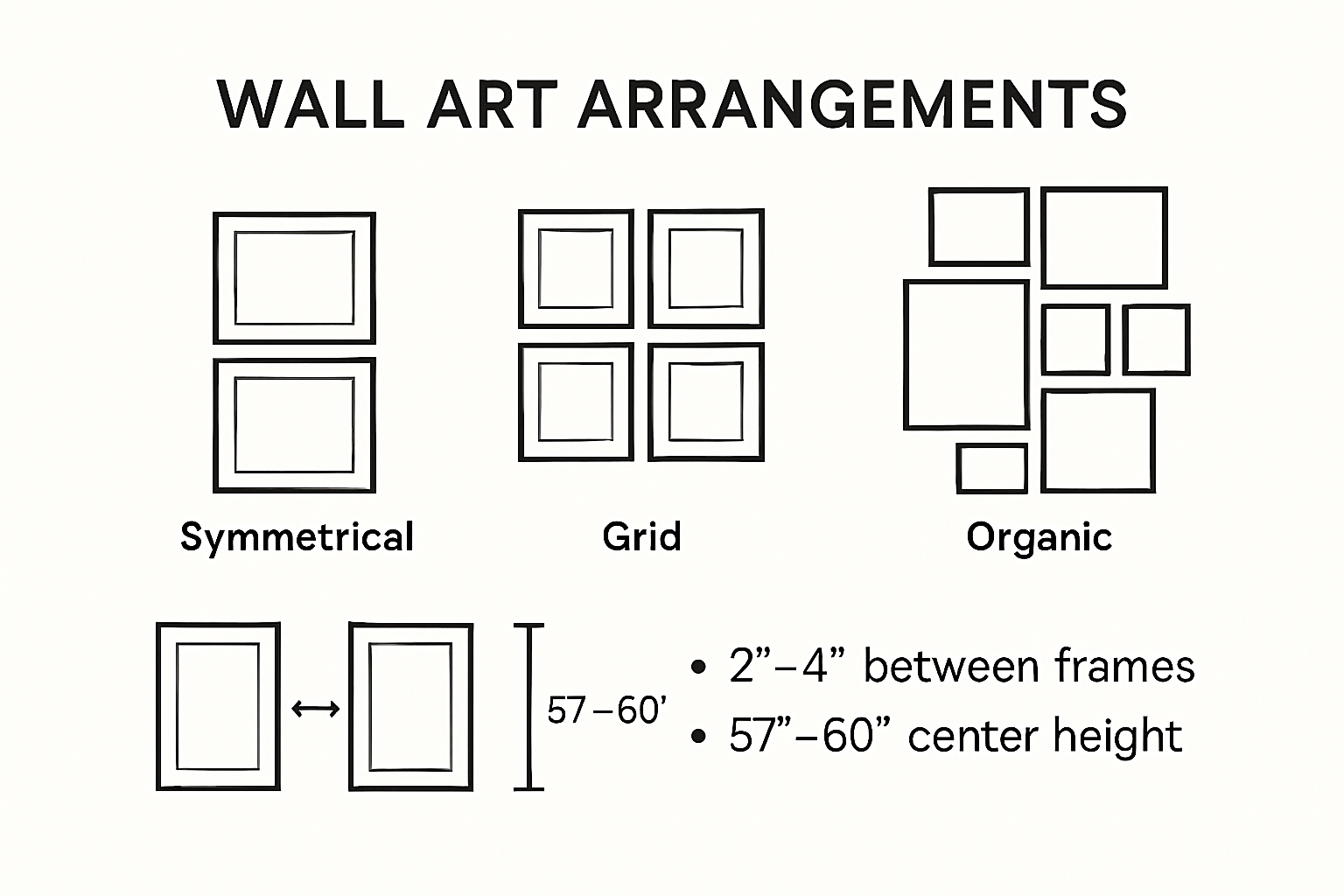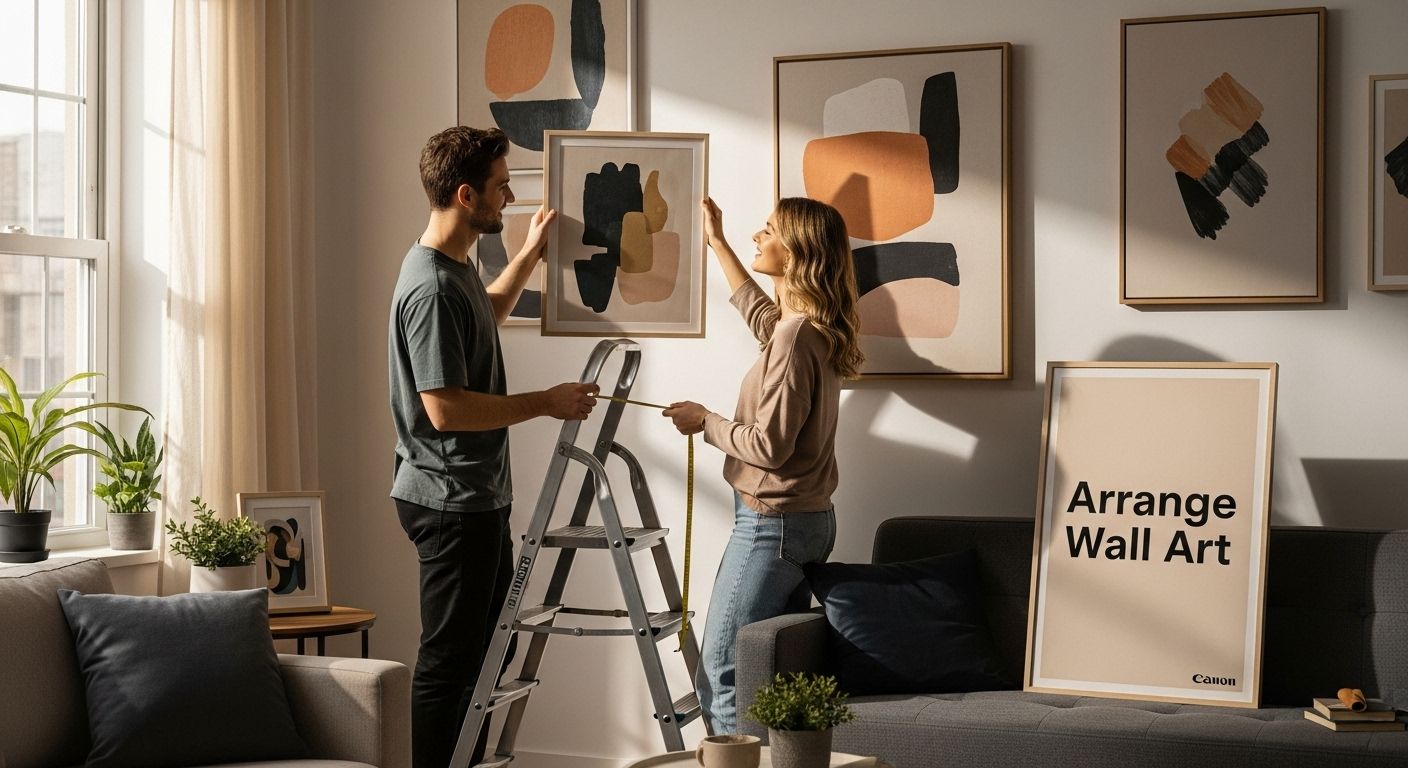How to Arrange Wall Art for Personalized Home Decor

Wall art does more than just fill an empty space. Nearly 75 percent of homeowners say their mood is improved just by seeing art that is personally meaningful. Most people hang a few pictures and call it a day and miss out on the power of storytelling their walls could hold. Real impact happens when you arrange your art as a reflection of your unique story, not just your style.
Table of Contents
- Choosing The Perfect Wall Art For Your Space
- Planning Your Wall Art Layout Like A Pro
- Tips For Arranging Personalized And Custom Pieces
- Creative Ideas For Gifts And Family Wall Displays
Quick Summary
| Takeaway | Explanation |
|---|---|
| Select art that reflects your style | Choose wall art that resonates with your aesthetic and emotions for a personal touch. |
| Plan your layout before hanging | Use templates or painter’s tape to visualize art arrangements effectively without damaging walls. |
| Create balance in your display | Arrange pieces with proportional spacing and consider focal points for visual harmony. |
| Tell a story with personal pieces | Group personalized art into themes that narrate your journey and evoke emotions. |
| Utilize negative space for impact | Ensure artwork has breathing room on walls to enhance visibility and create a thoughtful arrangement. |
Choosing the Perfect Wall Art for Your Space
Selecting the right wall art transforms a house into a home, creating spaces that reflect personal style, emotion, and individual narrative. Thoughtful art selection goes beyond mere decoration. Discover more about creating meaningful decor and understand how your walls can tell your unique story.
Understanding Your Personal Style
Your wall art should be an authentic representation of your personality and aesthetic preferences. According to research published in the International Journal of Environmental Research and Public Health, art selection is deeply connected to personal meaning and cultural values. This means your chosen pieces should resonate with your emotional landscape.
Start by evaluating your existing interior design. Consider the color palette, furniture style, and overall mood of your space. Are you drawn to minimalist, modern designs with clean lines and neutral tones? Or do you prefer eclectic, vibrant arrangements that showcase bold colors and varied textures? Your wall art should complement and enhance your existing decor, creating a harmonious visual experience.
Sizing and Placement Strategies
Scale plays a crucial role in wall art selection. Smaller spaces benefit from carefully curated pieces that do not overwhelm the room, while larger areas can accommodate more substantial or multiple art installations. Consider the wall dimensions and furniture placement when choosing artwork.
For standard living rooms, aim to cover approximately 50-75% of the wall space with your chosen art pieces. Large statement pieces work best when centered above furniture like sofas or consoles. Gallery walls offer flexibility, allowing you to mix different sizes and styles to create visual interest. Remember that negative space is equally important as the art itself - allow your pieces room to breathe and make an impact.
When selecting wall art, prioritize pieces that spark joy and tell your personal story. Whether it’s a cherished photograph, an abstract painting, or a custom metal sign, each piece should contribute to the narrative of your living space. The most compelling wall art collections are those that reflect the unique journey and personality of their owners.
Pro tip: Always measure your wall space before purchasing art. Use painter’s tape to create visual templates on the wall, helping you understand how different sizes and arrangements might look before making a final decision.
Planning Your Wall Art Layout Like a Pro
Creating a stunning wall art arrangement requires strategic planning and an understanding of design principles. Learn more about crafting personalized decor layouts that transform your space into a captivating visual narrative.
Creating Balance and Visual Harmony
Balancing wall art is an art form that goes beyond simply hanging pictures. Professional interior designers recommend creating visual weight through strategic placement and composition. Consider your wall as a canvas where each piece contributes to an overall storytelling experience.
Start by selecting a focal point - this could be a larger statement piece or a collection of smaller artworks that work together. The key is maintaining proportional relationships between pieces. As design experts suggest, leaving 2-3 inches of space between frames helps create a cohesive look without making the arrangement feel cluttered.
Layout Planning Techniques
Before putting any holes in your walls, develop a comprehensive layout strategy. Professional designers recommend using paper templates or painter’s tape to map out potential arrangements. This technique allows you to visualize the final composition without committing to permanent placement.
Consider different layout styles:
- Symmetrical Arrangements: Create mirror-image layouts with identical spacing, perfect for formal spaces
- Grid Layouts: Align pieces in precise horizontal and vertical lines for a clean, modern aesthetic
- Organic Gallery Walls: Mix different frame sizes and orientations for a more dynamic, personal feel
Here is a quick guide comparing popular wall art layout styles and when to use them. This table will help you decide which arrangement best suits your space and personal story.
| Layout Style | Description | Best For |
|---|---|---|
| Symmetrical Arrangements | Mirror-image layouts with identical spacing | Formal, traditional spaces |
| Grid Layouts | Pieces aligned in precise lines horizontally and vertically | Modern, minimalist aesthetics |
| Organic Gallery Walls | Mixed frame sizes and orientations in a freeform, dynamic composition | Eclectic, personal storytelling |
| Chronological Displays | Art or photos arranged in sequence to document milestones | Family history or life events |
| Thematic Groupings | Grouping similar colors, frames, or emotional themes together | Unified visual narratives |
| Mixed Media Arrangements | Combining photographs, canvases, and custom objects in a single collection | Creative, personalized flair |
Measurement is crucial. Typically, artwork should be hung at eye level, which means the center of your piece should be approximately 57-60 inches from the floor. This creates a natural viewing perspective that works well in most spaces.

For larger walls, experiment with creating visual connections between pieces. Use consistent color themes, matching frame styles, or complementary artistic elements to tie your collection together. Remember that negative space is just as important as the art itself - allow your pieces room to breathe and make an impact.
Pro tip: Take a photograph of your proposed layout and view it digitally. This helps you assess the overall composition more objectively and make necessary adjustments before final installation. A well-planned wall art arrangement can transform an ordinary room into a personalized sanctuary that reflects your unique style and story.
Tips for Arranging Personalized and Custom Pieces
Personalized wall art transforms living spaces into deeply meaningful narratives that reflect individual stories and experiences. Explore creative ways to personalize your home decor and turn your walls into a canvas of personal expression.
Creating Meaningful Visual Narratives
Custom pieces require thoughtful arrangement that goes beyond standard decorating principles. According to Better Homes & Gardens, visual balance is crucial when displaying personalized artwork. Typically, heavier pieces should be positioned at the bottom and left side of your arrangement, as the human eye naturally begins scanning from the left.
When curating personalized art, consider creating thematic collections that tell a cohesive story. Family photographs, custom artwork, and meaningful memorabilia can be strategically grouped to create powerful visual narratives. Group pieces with similar color schemes, matching frames, or complementary themes to create a unified display that feels intentional and personal.
Balancing Personalization and Design Aesthetics
According to 1stDibs design experts, symmetrical arrangements work best for personalized collections when pieces share consistent characteristics. For custom artwork, this might mean using frames of similar sizes, colors, or styles to create a harmonious look.
When hanging personalized pieces over furniture, follow the two-thirds rule recommended by Riverbend Home. Your artwork should occupy approximately two-thirds the width of the furniture beneath it, creating a balanced and visually appealing composition.
Consider these strategies for arranging personalized pieces:
- Chronological Displays: Arrange family photos or milestone artwork in sequence
- Thematic Groupings: Cluster pieces that share emotional or visual connections
- Mixed Media Arrangements: Combine different types of personalized art like photographs, custom metal signs, and canvas prints
Below is a summary table highlighting key tips and strategies for arranging personalized and custom wall art. Use this checklist to ensure your arrangement feels intentional and meaningful.
| Strategy | Key Point |
|---|---|
| Heavier Pieces Placement | Position heavier art at the bottom and left for balance |
| Cohesive Themes | Group pieces with similar colors, frames, or emotional connections |
| Consistent Framing | Use same frame sizes and styles in symmetrical arrangements |
| Two-Thirds Rule | Art should occupy about two-thirds the width of furniture below |
| Chronological/Thematic Order | Arrange photos/art by timeline or related themes |
| Mixed Media Combination | Incorporate photos, custom metal signs, and prints for texture and interest |
| Paper Template Planning | Place paper templates to experiment with layouts before committing |
Pro tip: Before final installation, create paper templates of your personalized pieces. Arrange these on the wall to experiment with different layouts without making permanent marks. This approach allows you to visualize the final arrangement and make adjustments to achieve the most compelling and meaningful display.
Remember that personalized wall art is more than decoration - it’s a reflection of your unique journey, memories, and personal aesthetic. Each piece should spark joy and tell a part of your story, transforming your living space into a deeply personal sanctuary.
Creative Ideas for Gifts and Family Wall Displays
Wall art transforms into more than just decoration when it becomes a storytelling medium for families and gift-giving. Discover unique ways to create meaningful home decor gifts that capture memories and celebrate personal connections.
Innovative Family Memory Displays
Family wall displays offer powerful opportunities to preserve and showcase generational stories. According to research exploring intergenerational communication, creative wall art can strengthen familial bonds by highlighting shared experiences and personal narratives.
Consider creating multi-generational display strategies that go beyond traditional photo arrangements. Timeline collections can document family history, featuring vintage photographs alongside contemporary images. Mix different media types - incorporate vintage letters, handwritten recipes, birth certificates, or significant family documents to add depth and context to your visual narrative.
Personalized Gift Presentation Techniques
When selecting wall art as a gift, focus on pieces that reflect the recipient’s unique personality and life journey. Interactive and dynamic display methods can elevate the gifting experience. Classroom design experts suggest using flexible display systems that allow easy content modification, a principle equally applicable to home decor.
Gift ideas for personalized wall displays include:
- Milestone Collections: Curate artwork celebrating significant life events
- Travel Memory Walls: Showcase maps, photographs, and mementos from shared adventures
- Professional Achievement Galleries: Display diplomas, awards, and career highlights
Pro tip: Consider creating themed wall collections that tell a story. For instance, a wedding anniversary display might include the couple’s first dance photograph, love letters, and significant relationship milestones. The key is creating a narrative that feels personal and emotionally resonant.
Remember that the most meaningful wall art transcends mere visual appeal. It becomes a conversation starter, a memory keeper, and a testament to the relationships and experiences that shape our lives. Each carefully chosen piece transforms a simple wall into a dynamic, living narrative of personal history and connection.

Frequently Asked Questions
How do I choose the right wall art for my space?
Select wall art that reflects your personal style and resonates with your emotions. Consider the existing interior design, including colors and textures, to ensure a harmonious fit.
What are the best strategies for arranging wall art?
Use layout techniques such as symmetrical arrangements, grid layouts, or organic gallery walls. Experiment with paper templates or painter’s tape on the wall to visualize your arrangements before making permanent placements.
How can I create a meaningful narrative with my wall art?
Group your art pieces thematically to tell a story that reflects your personal journey. Use similar colors, frame styles, or emotional connections to weave a cohesive visual narrative.
Why is sizing and placement important for wall art?
Scaling and placement affect the overall impact of wall art. Larger pieces should dominate larger walls, while smaller artworks should fit proportionally in tighter spaces, ensuring visual balance without overcrowding.
Elevate Your Wall Art Story with Personalized Creations
Are you struggling to bring true personality and meaning to your wall art arrangements? Many readers find that ordinary store-bought art fails to tell their family’s story or capture meaningful memories, even after carefully following layout tips and sizing strategies. What truly transforms a space is incorporating custom artwork that reflects names, dates, and moments unique to you. The article shows how powerful it is to arrange artwork in a way that shares your journey—but finding art that connects emotionally is still a challenge for most.
Personalized Canvas Wall Art Prints from FunLifeNow make it easy to create a story-driven display with your own names, important dates, or heartfelt messages. Experience American craftsmanship, long-lasting quality, and easy customization for every room.

Ready to make your walls a reflection of your life? Explore more options at FunLifeNow or browse our Personalized Custom Metal Decor Wall Art collection today. Start turning empty walls into meaningful memories—personalize your art now and see the difference in how your home feels.
Recommended
- What Is Wall Art? Your Guide to Personalized Decor in 2025 – FunLifeNow
- What Is Wall Art? Your Guide to Personalized Decor in 2025 – FunLifeNow
- How to Choose Wall Art for Meaningful Decor in 2025 – FunLifeNow
- How to Choose Wall Art for Meaningful Decor in 2025 – FunLifeNow
- How to Personalize Gifts: Creative Ideas for Every Occasion – Personalise4uLtd
